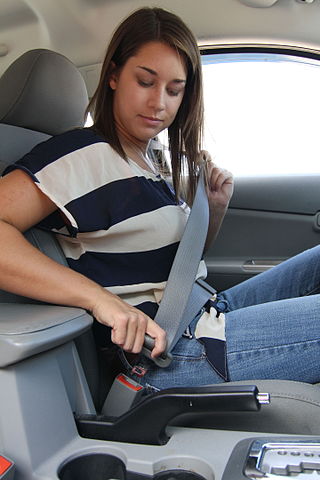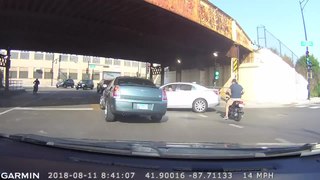
A seat belt, also known as a safety belt or spelled seatbelt, is a vehicle safety device designed to secure the driver or a passenger of a vehicle against harmful movement that may result during a collision or a sudden stop. A seat belt reduces the likelihood of death or serious injury in a traffic collision by reducing the force of secondary impacts with interior strike hazards, by keeping occupants positioned correctly for maximum effectiveness of the airbag, and by preventing occupants being ejected from the vehicle in a crash or if the vehicle rolls over.
Drunk driving is the act of operating a motor vehicle with the operator's ability to do so impaired as a result of alcohol consumption, or with a blood alcohol level in excess of the legal limit. For drivers 21 years or older, driving with a blood alcohol concentration (BAC) of 0.08% or higher is illegal. For drivers under 21 years old, the legal limit is lower, with state limits ranging from 0.00 to 0.02. Lower BAC limits apply when operating boats, airplanes, or commercial vehicles. Among other names, the criminal offense of drunk driving may be called driving under the influence (DUI), driving while intoxicated or impaired (DWI), operating [a] vehicle under the influence of alcohol (OVI), or operating while impaired (OWI).

Crumple zones, crush zones, or crash zones are a structural safety feature used in vehicles, mainly in automobiles, to increase the time over which a change in velocity occurs from the impact during a collision by a controlled deformation; in recent years, it is also incorporated into trains and railcars.

Automotive safety is the study and practice of automotive design, construction, equipment and regulation to minimize the occurrence and consequences of traffic collisions involving motor vehicles. Road traffic safety more broadly includes roadway design.

A school bus is any type of bus owned, leased, contracted to, or operated by a school or school district. It is regularly used to transport students to and from school or school-related activities, but not including a charter bus or transit bus. Various configurations of school buses are used worldwide; the most iconic examples are the yellow school buses of the United States which are also found in other parts of the world.

Click It or Ticket is a National Highway Traffic Safety Administration campaign aimed at increasing the use of seat belts among young people in the United States. The campaign relies heavily on targeted advertising aimed at teens and young adults.
Seat belt legislation requires the fitting of seat belts to motor vehicles and the wearing of seat belts by motor vehicle occupants to be mandatory. Laws requiring the fitting of seat belts to cars have in some cases been followed by laws mandating their use, with the effect that thousands of deaths on the road have been prevented. Different laws apply in different countries to the wearing of seat belts.

A traffic stop, colloquially referred to as being pulled over, is a temporary detention of a driver of a vehicle and its occupants by police to investigate a possible crime or minor violation of law.

The National Traffic and Motor Vehicle Safety Act was enacted in the United States in 1966 to empower the federal government to set and administer new safety standards for motor vehicles and road traffic safety. The Act was the first mandatory federal safety standards for motor vehicles. The Act created the National Highway Safety Bureau. The Act was one of a number of initiatives by the government in response to increasing number of cars and associated fatalities and injuries on the road following a period when the number of people killed on the road had increased 6-fold and the number of vehicles was up 11-fold since 1925. The reduction of the rate of death attributable to motor-vehicle crashes in the United States represents the successful public health response to a great technologic advance of the 20th century—the motorization of the United States.
Atwater v. Lago Vista, 532 U.S. 318 (2001), was a United States Supreme Court decision which held that a person's Fourth Amendment rights are not violated when the subject is arrested for driving without a seatbelt. The court ruled that such an arrest for a misdemeanor that is punishable only by a fine does not constitute an unreasonable seizure under the Fourth Amendment.
For driving in the United States, each state and territory has its own traffic code or rules of the road, although most of the rules of the road are similar for the purpose of uniformity, given that all states grant reciprocal driving privileges to each other's licensed drivers. There is also a "Uniform Vehicle Code" which was proposed by a private, non-profit group, based upon input by its members. The UVC was not adopted in its entirety by any state. As with uniform acts in general, some states adopted selected sections as written or with modifications, while others created their own sui generis statutes touching upon the same subject matter. As required by the federal Highway Safety Act of 1966, all states and territories have adopted substantially similar standards for the vast majority of signs, signals, and road surface markings, based upon the Manual on Uniform Traffic Control Devices from the U.S. Department of Transportation. Many of the standard rules of the road involve consistent interpretation of the standard signs, signals, and markings such as what to do when approaching a stop sign, or the driving requirements imposed by a double yellow line on the street or highway. In order to implement their own traffic laws on the property of their own facilities, several federal agencies have also developed their own traffic laws.
Many countries have adopted a penalty point or demerit point system under which a person’s driving license is revoked or suspended based on the number of points they’ve accumulated over a specific period of time, points are given for traffic offenses or infringements committed by them in that period. The demerit points schemes of each jurisdiction varies. These demerit schemes are usually in addition to fines or other penalties which may be imposed for a particular offence or infringement, or after a prescribed number of points have been accumulated.

Transportation safety in the United States encompasses safety of transportation in the United States, including automobile crashes, airplane crashes, rail crashes, and other mass transit incidents, although the most fatalities are generated by road incidents annually killing 32,479 people in 2011 to over 42,000 people in 2022. The number of deaths per passenger-mile on commercial airlines in the United States between 2000 and 2010 was about 0.2 deaths per 10 billion passenger-miles. For driving, the rate was 150 per 10 billion vehicle-miles: 750 times higher per mile than for flying in a commercial airplane.

86 percent of people in the United States use private automobiles as their primary form of transportation to their workplace.

A traffic collision, also known as a motor vehicle collision, occurs when a vehicle collides with another vehicle, pedestrian, animal, road debris, or other moving or stationary obstruction, such as a tree, pole or building. Traffic collisions often result in injury, disability, death, and property damage as well as financial costs to both society and the individuals involved. Road transport is statistically the most dangerous situation people deal with on a daily basis, but casualty figures from such incidents attract less media attention than other, less frequent types of tragedy. The commonly used term car accident is increasingly falling out of favor with many government departments and organizations, with the Associated Press style guide recommending caution before using the term. Some collisions are intentional vehicle-ramming attacks, staged crashes, vehicular homicide or vehicular suicide.

In traffic laws, a hit and run or a hit-and-run is the criminal act of causing a traffic collision and not stopping afterwards. It is considered a supplemental crime in most jurisdictions.
Seat belt legislation in Canada is left to the provinces. All provinces in Canada have primary enforcement seat belt laws, which allow a police officer to stop and ticket a driver if they observed a violation. Ontario was the first province to pass a law which required vehicle occupants to wear seat belts, a law that came into effect on January 1, 1976.
Williamson v. Mazda Motor of America, Inc., 562 U.S. 323 (2011), was a decision by the Supreme Court of the United States, in which the Court unanimously held that Federal Motor Vehicle Safety Standard 208, promulgated by the National Highway Traffic Safety Administration, does not federally preempt state tort lawsuits against auto manufacturers from injuries caused by a defective lack of certain types of seat belts.

Various laws in the United States regulate the use of mobile phones and other electronics by motorists. Different states take different approaches. Some laws affect only novice drivers or commercial drivers, while some laws affect all drivers. Some laws target handheld devices only, while other laws affect both handheld and handsfree devices.

People who are driving as part of their work duties are an important road user category. First, workers themselves are at risk of road traffic injury. Contributing factors include fatigue and long work hours, delivery pressures, distractions from mobile phones and other devices, lack of training to operate the assigned vehicle, vehicle defects, use of prescription and non-prescription medications, medical conditions, and poor journey planning. Death, disability, or injury of a family wage earner due to road traffic injury, in addition to causing emotional pain and suffering, creates economic hardship for the injured worker and family members that may persist well beyond the event itself.













